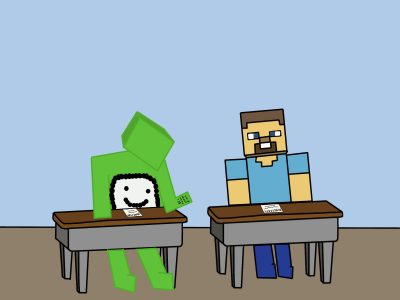Minecraft’s multigenerational staying power makes it unusual in the video game world. It is exceedingly rare for any cultural product, not just a video game, to maintain popularity for a decade.
The cultural relevance of a movie usually fades, long-running TV shows end — or jump the metaphorical shark — and any one video game will often be rendered technologically obsolete by its sequels. But Minecraft, released in 2011, seems more popular than ever.
One YouTuber named Dream, whose real identity is unknown, is the beating heart of Minecraft’s online resurgence. With 17.7 million subscribers, he won first and second place on YouTube’s 2020 “Top ‘Breakout’ YouTube Creators” and “Top YouTube Creators” lists, respectively.

It helps that videos and livestreams of the “Dream SMP” — a Minecraft server frequented by Dream himself and other YouTubers — has become a sort of digital soap opera. In an article for WIRED, staff writer Cecilia d’Anastasio likened the spectacle of the SMP to a stage play with no pit, where social media blurs the lines between performer and audience.
Of course, like every internet figure of his size, Dream has also been immersed in controversy.
For the uninitiated, Dream’s rise is largely the product of his career as a Minecraft “speedrunner,” or a player who attempts to complete the game in single-player mode as fast as possible. In December, site moderators decided to remove his fifth-place personal best from the Minecraft speedrun rankings.
Dream’s credibility as a competitor was destroyed in full view of the public.
Apparently, the decision came after a two-month investigation into Dream’s unusually good luck with random in-game events during speedrun attempts. Archives of his livestreams were analyzed by Minecraft enthusiasts who studied statistics and computer science in their real lives, and the results of this investigation were compiled into a research paper.
Of course, Dream was outraged by the entire process. On social media, he made various false claims — essentially saying his popularity made him an easy target for a biased investigation. He also paid an anonymous astrophysicist to write another paper exonerating him.
Australian standup comedian and mathematician Matt Parker called this response “maths chaff,” explaining how the paper tried to obscure Dream’s guilt behind jargon.
In “culturally marginalized” groups — such as those in Minecraft — renowned author David Foster Wallace once wrote, “there are cliques, anticliques, alliances, betrayals, conflagratory rumors, legendary enmities, and public bloodlettings, plus involved hierarchies of popularity and influence.”
The Dream situation is nothing if not a “public bloodletting.” Indeed, in the many competitive games that I follow, this kind of infighting is commonplace. Subcultures isolated from popular culture feel a lot like high school.
Even communities with no nexus to video games have this sort of drama, such as the subreddit Hobby Drama — its highest-rated posts describe incidents ranging from accusations of using lip balm to cheating at chess to a dispute over intellectual property in cheesemaking.
As complicated as the Dream verdict was, it is a useful tool for understanding why this happens.
For one thing, it shows how social media can escalate these situations. The aforementioned “stage with no pit” of internet celebrity goes both ways. The audience may be closer to their favorite creators, but this also makes it easy to boo and throw tomatoes.
In this case, both the pro- and anti-Dream camps spewed hateful messages.
Material concerns are also partially to blame. Dream has unsurprisingly monetized his meteoric rise: opening a merch store, starting a Patreon and adding paid promotions to his videos.
His popularity is predicated on his speedrunning skill. Even if he only began to cheat recently, he may have done so to meet the expectations he set on his quest for money and fans.
Money is a major factor in so much of the drama that tears people apart: prize money won by cheaters, money spent on failed promises, money borrowed and never given back and money used for bribery.
This drama seems to be a natural consequence of our increasingly stratified society as well. Subculture is, by definition, removed from the mainstream culture.
In the real world, the powerful go unpunished for their sins. The wealth gap is only growing larger, but President Joe Biden promised his wealthiest donors “nothing would fundamentally change.”
Inside the Minecraft community, however, retribution can be swift. Dream was the subject of 29 pages of incriminating research, removal from the leaderboards, barbed YouTube takedowns and endless memes.
Infighting happens in part because we encourage it. When our politicians never receive real punishments, is it any surprise that we love to see them in subculture?
Even though his embarrassment became a spectacle, Dream is doing just fine, of course. He gained 1.7 million subscribers in the month of January — while cheating accusations were rolling out. Perhaps the real takeaway is that the saying “cheaters never prosper” is a lie.





















































































































